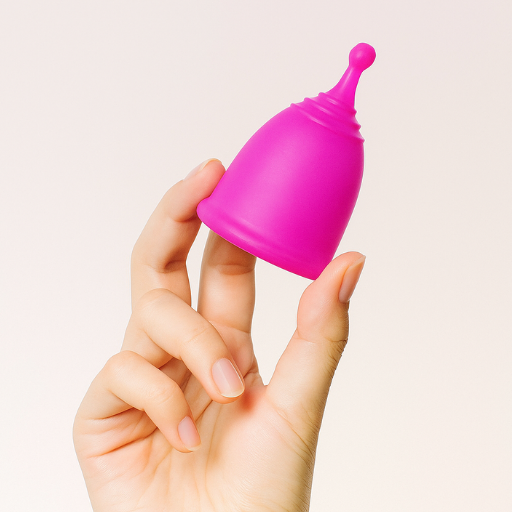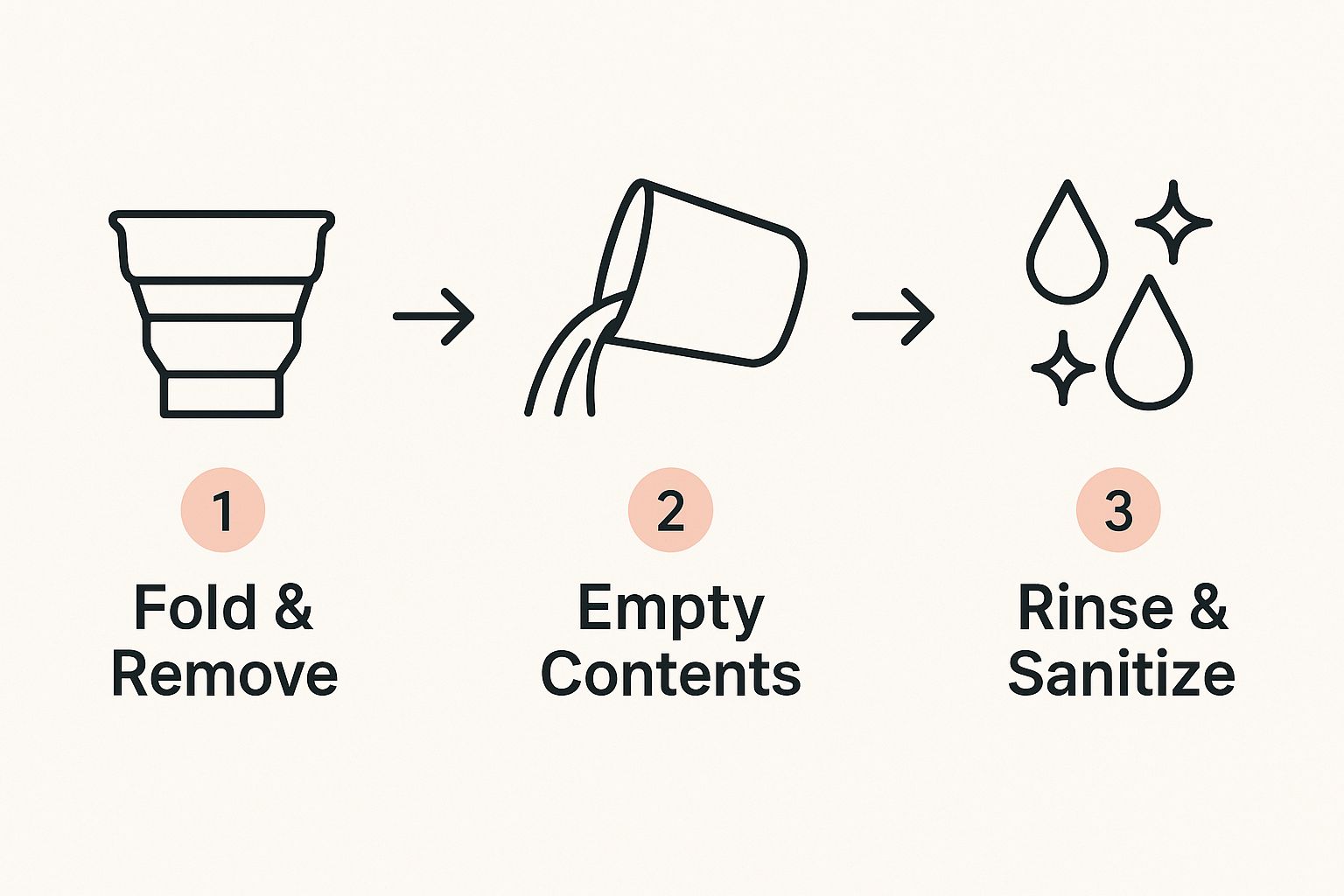
How Do You Use a Menstrual Period Cup? Complete Guide for Beginners
Share
Feeling curious about menstrual cups but also a little intimidated? You’re not alone. The whole idea can feel a bit strange at first, but we're here to walk you through it with a friendly, straightforward guide.
How do you use a menstrual cup?
You simply fold the flexible cup, insert it into your vaginal canal where it pops open to form a gentle seal, and then go about your day. It can stay in for up to 12 hours, collecting your flow instead of absorbing it. When it's time, you just remove it, empty it, give it a rinse, and reinsert. It’s a completely different, and for many, a more comfortable way to manage your period.
Your First Guide to Menstrual Cups
If you've ever found yourself staring at a bathroom bin full of single-use period products and thought, "there has to be a better way," you're in the right place. Let's have a friendly chat about making the switch to reusable period care.
A menstrual cup is a small, flexible, bell-shaped cup, usually made from medical-grade silicone. Unlike a digital (non-applicator) tampon that absorbs your flow, a cup simply collects it. This fundamental difference is key to its comfort and long wear time.
This shift towards reusables is really taking off in New Zealand, and for good reason. The benefits are hard to ignore:
- Less Waste: One cup can last for years, which dramatically shrinks your environmental footprint.
- Cost Savings: Think of all the money spent on monthly tampon or pad purchases. A single cup can save you hundreds of dollars over its lifespan.
- Longer Wear: Being able to wear it for up to 12 hours means fewer interruptions and less to think about during your day.
A Sustainable Choice for New Zealand
The environmental cost of disposable period products is huge. In New Zealand, with around 1.2 million people of menstrual age, we use about 350 million tampons and pads every year. That adds up to roughly 5,000 tonnes of waste heading to our landfills annually.
A reusable menstrual cup, which can last up to 10 years, is a powerful way to cut down on that waste. It's a real step towards both period equity and sustainability. You can read more on how reusable products are creating waste-free periods.
For most people, the biggest hurdle is that initial feeling of, "Can I really do this?" It’s a totally valid question, and it’s completely normal to feel a bit hesitant. Learning to use a cup means getting to know your body a little better, which can be an empowering experience in itself. This guide is here to walk you through every step, creating a supportive space to explore a more sustainable and comfortable period.
How to Choose the Right Menstrual Cup
The secret to a great menstrual cup experience is finding your perfect match. This definitely isn't a one-size-fits-all product, and picking the right one from the get-go sets you up for a comfortable, leak-free period.
When you’re wondering how do you use a menstrual period cup effectively, it all starts with this first step. There are three main things to consider: your cervix height, your flow, and the firmness of the cup. Getting these right makes all the difference.
Finding Your Fit
Let's break down what you need to know about your own body.
- Cervix Height: Your cervix can sit high or low, and it actually moves during your cycle. A shorter cup is ideal for a low cervix, while a longer one will be more comfortable if you have a high cervix.
- Menstrual Flow: Cups come in different sizes and capacities. If you have a heavier flow, a larger cup means fewer trips to the bathroom. For a lighter flow, a smaller size is often much more comfortable.
- Cup Firmness: The cup's flexibility matters, too. Softer cups are often a better choice for those with bladder sensitivity or intense cramps. On the other hand, firmer cups can be easier to pop open and create a really strong seal, making them great for people with strong pelvic floor muscles.
Finding the right combination might take a little trial and error, but understanding your body is the best place to start. To measure your cervix height, just insert a clean finger into your vagina until you feel a firm spot that feels a bit like the tip of your nose—that’s your cervix. You can use your knuckles as a rough guide to estimate how high or low it is.
It's interesting to note that while a single menstrual cup can hold as much as two or three tampons, they are still not a mainstream choice for many young people in Aotearoa. A recent RNZ focus group found only one in six teens regularly used a cup, with many still using digital tampons despite comfort and health concerns. Learn more about teen perspectives on period products.
This really highlights how important good information is. When you choose a cup tailored to your needs, you're setting yourself up for success from day one. You can explore a variety of menstrual cups to see the different sizes and shapes available.
Mastering the Fold and Insertion
This is often the part that feels the most intimidating, but trust us, it becomes second nature with just a little bit of practice. Getting the hang of a menstrual cup is all about finding what works for your unique body.
First things first: relax! Tense pelvic floor muscles will only make things more difficult. Try taking a few deep, calming breaths before you begin. For many people, a comfortable position is key—this could be squatting, sitting on the toilet, or standing with one leg propped up on the side of the bath.
Finding Your Favourite Fold
Folding the cup makes it smaller and way easier to insert. There’s no single "best" method; it’s all about what feels right for you. If one fold doesn’t work, don't sweat it—just try another!
- The C-Fold: This is one of the most common and simplest folds. Just press the sides of the cup together to flatten it, then fold it in half to create a ‘C’ or ‘U’ shape.
- The Punch-Down Fold: A great option for beginners because it creates a much smaller, more tapered insertion point. All you do is push one side of the rim down into the base of the cup.
This simple infographic breaks down the basic cycle of using your cup.

Once you’ve got your fold sorted, gently guide the cup into your vagina, aiming it back towards your tailbone, not straight up. If you've used digital tampons before, the angle is pretty similar. For a refresher, our guide on how to insert a tampon offers some useful tips on positioning.
The most important step is making sure the cup has fully opened once it's inside. You can check this by running a finger around the base of the cup. If you feel any dents or folds, gently twist the cup or give the base a little pinch to help it pop open and create that all-important leak-proof seal.
Time to Take It Out? A Guide to Removal and Cleaning
Alright, your cup is in and doing its thing. But what about when it's time to take it out? The first time can feel a little intimidating, but I promise you, it absolutely cannot get lost inside you.
The number one rule for removal is to relax. Tense pelvic floor muscles will grip the cup tighter, so take a few deep, calming breaths. Just like with insertion, finding a comfortable position—like sitting on the toilet or squatting in the shower—can make all the difference.
Breaking the Seal for a Smooth Exit
The whole secret to a painless, easy removal is breaking the suction seal first. Never just yank on the stem; this can cause some serious discomfort and won't actually release the cup. Instead, bear down gently with your pelvic muscles (like you're having a bowel movement) to push the cup a little lower.
Now, reach up and pinch the ridged base of the cup firmly between your thumb and forefinger. You might even hear or feel a little whoosh as the seal breaks. Once that suction is gone, you can gently wiggle the cup out, trying to keep it upright to avoid any spills.
You can safely wear your menstrual cup for up to 12 hours, but you’ll quickly get to know your own flow and figure out the best emptying schedule for your body. When you're ready, just tip the contents into the toilet.
A big worry for many is how to empty a cup in a public bathroom. It's way easier than it sounds! You can simply wipe it out with toilet paper and pop it back in, or carry a small water bottle into the stall for a quick, private rinse. No one will ever know.
Keeping Your Cup Squeaky Clean
Looking after your cup properly is the key to making it last for years. After emptying, always rinse it with cold water first—this is a great trick to help prevent staining. Then, give it a proper wash with warm water and a mild, fragrance-free soap.
Between each cycle, you’ll need to sterilise your cup. The easiest way is to just boil it in a pot of water on the stove for about 5–10 minutes. This makes sure it's perfectly hygienic and ready to go for your next period.
Troubleshooting Common Cup Concerns
Even the most seasoned cup user had a first time, and let's be real—it probably wasn't perfect. If you're dealing with minor leaks, a bit of discomfort, or fumbling with removal, you're in good company. Think of it as a learning curve, not a failure. A little trial and error is a completely normal part of the process.
You're not alone if things don't feel quite right at first. Research backs this up, showing that it’s common for new users to need a little time to adjust. In fact, a study on young users found that during their first cycle, 54% experienced some leakage and 45% initially struggled to remove their cup.
The good news? These issues dropped off significantly as they got the hang of it. You can check out the details in this study on menstrual cup use and acceptability.
Pinpointing the Problem
Let's get into some practical solutions for the most common hiccups. These quick fixes can help you find your groove and enjoy a more comfortable, leak-free period.
-
Minor Leaks: The number one culprit is usually an incomplete seal. After you insert your cup, run a finger around the base to check for any dents or folds. If you feel one, gently twist the cup or give the base a little pinch to help it pop open fully. Sometimes it's just a positioning issue—try inserting it slightly higher or lower to see what feels best.
-
Discomfort or Pressure: If you feel a constant pressure, especially on your bladder, the cup might be a bit too firm or large for your anatomy. Everyone's body is different. A softer cup or a smaller size could be the perfect solution for you.
-
Removal Feels Tricky: The golden rule of removal is to break the seal first. Whatever you do, don't just pull on the stem—that's a recipe for discomfort. The trick is to relax your pelvic floor muscles (like you're about to pee), bear down gently to bring the cup lower, and then pinch the base of the cup firmly to release the suction before guiding it out.
Your comfort and health should always come first. While incredibly rare with menstrual cups, it's always smart to be informed about TSS. You can learn more about Toxic Shock Syndrome and your period products here to stay safe and aware.
Quick Fixes for Common Cup Concerns
If you're still a bit stuck, don't worry. Most issues have a simple fix. Here’s a quick-glance table to help you identify what might be going on and what to try next.
| Common Problem | Possible Cause | What to Try Next |
|---|---|---|
| It keeps leaking | The cup hasn't fully opened and sealed. | After inserting, run a finger around the base. Gently twist the cup or pinch the base to help it pop open. |
| It feels uncomfortable | The cup is too firm, too large, or positioned incorrectly. | Try a smaller or softer cup. Experiment with inserting it at a different angle or height. |
| I can't get it out | The seal hasn't been broken, and you're pulling on the stem. | Relax your muscles, bear down gently, and firmly pinch the base of the cup (not the stem) to break the seal. |
| It's hard to insert | You might be tense, or the fold isn't working for you. | Take a deep breath to relax your pelvic floor. Try adding a bit of water-based lubricant or experiment with a different fold, like the "punch-down" or "seven" fold. |
Think of this as your personal troubleshooting guide. With a bit of practice and patience, you'll find what works best for your body, and soon enough, using your cup will feel like second nature.
Your Top Menstrual Cup Questions, Answered
Let's be real—switching to a menstrual cup for the first time opens up a whole can of worms. It's a bit of a learning curve, and it’s completely normal to have a million questions before you take the plunge. We hear them all the time, so let's get into it.
How Often Do I Need to Empty My Cup?
This is easily one of the best perks of cup life: the freedom. Most people can comfortably and safely wear their cup for 8-12 hours at a time. Your own flow is going to be your ultimate guide, though.
On your heaviest days, you might find yourself needing to empty it every 6 to 8 hours just to stay ahead of any potential leaks. But as your period lightens up, you’ll probably settle into a simple twice-a-day routine. It only takes a cycle or two to get in sync with your body’s unique rhythm.
Can I Use a Cup if I Have an IUD?
Yep, you absolutely can. There's no solid scientific evidence showing that the gentle suction from a menstrual cup increases the risk of your IUD coming out.
The trick is all in the removal. You have to fully break the seal before you even think about pulling it out. Just pinch the base of the cup firmly until you feel or hear that little suction release. This stops any extra pressure from being put on your cervix or the IUD strings. If you're feeling at all hesitant, a quick chat with your doctor or gynaecologist can give you total peace of mind.
Ready to switch to a crimson menstrual cup or a cup and tampon bundle? Discover the perfect fit with Crimson Organic and join thousands of Kiwis making a positive change for their bodies and the planet. Explore our range of premium organic period care today!
